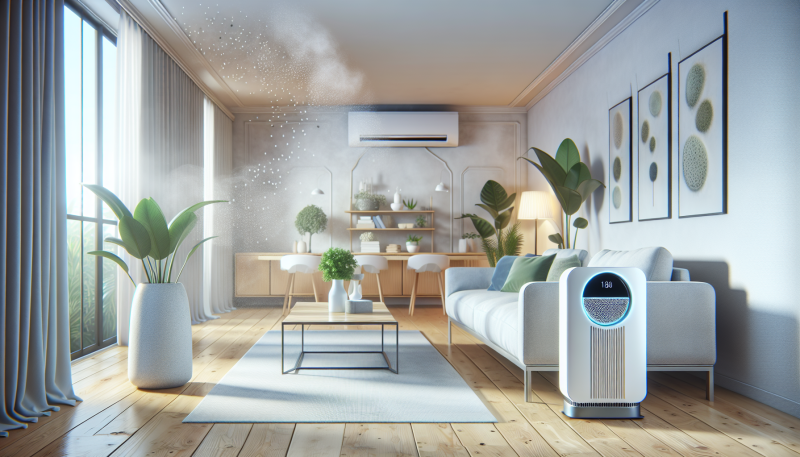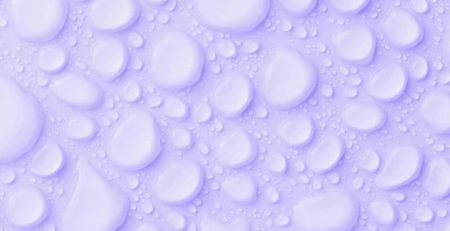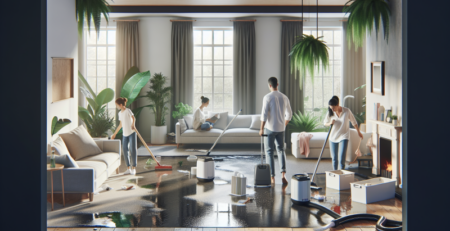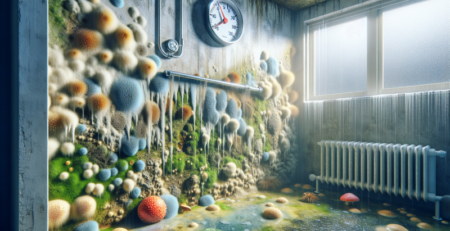The Role of Air Purifiers in Mold Prevention
**The Role of Air Purifiers in Mold Prevention**
Are you concerned about mold growth in your home? Understanding the role of air purifiers in mold prevention can be a game-changer for maintaining a healthy indoor environment. Mold thrives in damp, poorly ventilated spaces, and air purifiers can significantly reduce airborne spores, making them an essential tool in your mold prevention strategy.
Air purifiers work by filtering out mold spores and other allergens from the air, thus reducing the likelihood of mold growth. They can capture particles as small as 0.3 microns, effectively removing mold spores before they settle and proliferate. By maintaining optimal humidity levels and improving air quality, these devices play a crucial role in safeguarding your home against mold infestations.
But air purifiers are just one part of the equation. To truly combat mold, it’s vital to combine their use with proper ventilation and moisture control. So, let’s delve deeper into how air purifiers function, the best types for mold prevention, and expert tips on creating a mold-free environment in your home. Join us as we explore the science behind air purification and its impact on mold prevention!
Understanding Mold: Causes and Risks
Mold is a type of fungus that thrives in damp environments. It belongs to the biological classification of fungi, which includes various species. Common causes of mold growth in indoor spaces include high humidity levels, water leaks, and inadequate ventilation. These factors create an ideal breeding ground for mold spores, allowing them to proliferate rapidly.
Exposure to mold poses significant health risks. Individuals may experience allergies, respiratory issues, and even toxic effects from certain mold types. Symptoms can range from sneezing and coughing to more severe reactions, particularly in those with pre-existing conditions.
Statistics reveal that mold is a prevalent issue in many homes. Approximately 50% of homes in the United States have some form of mold contamination. This widespread presence can lead to serious health implications for residents. To mitigate these risks, it’s essential to address moisture problems promptly. Regular maintenance and mold cleanup services can help maintain a healthy living environment. For more information on preventing mold growth, visit our about page.
The Science of Air Purification
Air purifiers utilize various technologies to enhance indoor air quality. They often feature filtration systems that capture airborne particles. HEPA filters are particularly effective, trapping 99.97% of particles as small as 0.3 microns. Additionally, some models incorporate UV light, which neutralizes bacteria and viruses, further purifying the air.
In the market, you can find several types of air purifiers. Mechanical purifiers rely on filters to remove contaminants. Electronic purifiers use charged plates to attract and trap particles. Hybrid models combine both technologies, offering a comprehensive solution for air purification.
The Clean Air Delivery Rate (CADR) is crucial when evaluating an air purifier’s effectiveness. This metric measures the volume of filtered air delivered per minute. Higher CADR ratings indicate better performance in removing specific pollutants, such as dust, pollen, and smoke. Therefore, selecting a purifier with a suitable CADR for your space is essential. For more information on air quality solutions, visit our about page or explore our services. If you have specific needs, feel free to contact us for personalized advice.
The Connection Between Air Purifiers and Mold Prevention
Air purifiers play a crucial role in reducing mold spores in indoor environments. They effectively capture airborne particles, including mold spores, using HEPA filters. As a result, the air quality improves significantly. Furthermore, air purifiers help maintain optimal indoor humidity levels. Mold thrives in damp conditions, so controlling humidity is essential for prevention. Many air purifiers come equipped with dehumidifying features, which actively reduce moisture in the air.
Studies have shown that air purifiers can significantly lower mold spore counts. For instance, research indicates that using air purifiers can decrease mold levels by up to 50% in affected areas. Experts recommend using air purifiers in conjunction with other mold prevention strategies. This combination enhances overall effectiveness. Additionally, regular maintenance of air purifiers ensures they operate at peak efficiency.
For more information on how to protect your home from mold, visit our mold cleanup services. You can also learn about our water cleanup solutions to prevent mold growth. For any inquiries, feel free to contact us.
Choosing the Right Air Purifier for Mold Prevention
When selecting an air purifier for mold prevention, focus on key features that enhance effectiveness. First, ensure it has a true HEPA filter. This type of filter captures 99.97% of particles, including mold spores. Additionally, look for activated carbon filters. They help eliminate odors and volatile organic compounds (VOCs) that can accompany mold growth. Humidity control is another crucial feature. Maintaining optimal humidity levels can significantly reduce mold proliferation.
Several brands excel in mold prevention. For instance, the Coway AP-1512HH offers a robust filtration system and is suitable for medium-sized rooms. Alternatively, the Honeywell HPA300 is ideal for larger spaces, providing powerful air purification. Both models have received positive reviews for their effectiveness against mold.
Sizing your air purifier correctly is essential. For small rooms, a unit with a CADR (Clean Air Delivery Rate) of 100-150 is sufficient. In contrast, larger areas may require a CADR of 300 or more. Always check the manufacturer’s recommendations for room size to ensure optimal performance. For more information on our mold cleanup services, visit our website. If you have further questions, feel free to contact us.
Best Practices for Using Air Purifiers to Prevent Mold
To effectively prevent mold, optimal placement of air purifiers is crucial. Position them in high-moisture areas, such as bathrooms and kitchens. Additionally, place units in rooms with poor airflow. This strategy ensures maximum air circulation and filtration. Regular maintenance is essential for air purifiers to function effectively. Change filters every three months, or more frequently if you have pets or live in a dusty environment. Clean the exterior and interior components monthly to maintain efficiency.
Moreover, consider using dehumidifiers alongside air purifiers. Dehumidifiers help reduce humidity levels, creating an inhospitable environment for mold growth. Ensure proper ventilation in your home by opening windows and using exhaust fans. This practice allows fresh air to circulate, further diminishing moisture buildup.
For more information on mold prevention, visit our mold cleanup services. Additionally, explore our water cleanup options to address any underlying moisture issues. For further assistance, feel free to contact us.
Case Studies: Success Stories of Mold Prevention with Air Purifiers
In a recent case study, a family in a humid climate faced persistent mold issues in their basement. After installing an air purifier, they reported a significant reduction in mold spores. The homeowner stated, “We noticed a difference within weeks. The air feels cleaner, and we no longer see mold growth.” This transformation highlights the effectiveness of air purifiers in mold prevention.
Another example involves a commercial office space that struggled with mold due to poor ventilation. After implementing a comprehensive air purification system, the management observed a dramatic improvement. An expert in environmental health noted, “The air quality improved remarkably, leading to fewer employee sick days.” This scenario underscores the importance of air purifiers in maintaining a healthy environment.
Before these interventions, both locations experienced frequent mold-related issues. After the installation of air purifiers, they achieved cleaner air and reduced mold presence. For more insights on effective mold prevention strategies, visit our mold cleanup page. Additionally, explore our residential design projects for further inspiration.
Common Misconceptions About Air Purifiers and Mold
Air purifiers are often misunderstood when it comes to mold prevention. Many believe these devices can eliminate all mold spores in the air. However, this is not entirely accurate. While air purifiers can reduce airborne mold spores, they do not eradicate mold from surfaces or prevent its growth. Mold thrives in damp environments, and simply filtering the air does not address the root cause of the problem.
Additionally, some people think air purifiers serve as a complete solution for mold issues. In reality, they should be part of a broader strategy. Effective mold prevention requires controlling humidity levels and addressing water damage. Relying solely on an air purifier can lead to a false sense of security.
Moreover, not all air purifiers are created equal. Some models may lack the necessary filtration capabilities to capture smaller mold spores. Therefore, it’s crucial to choose a high-quality purifier designed for mold removal. For more information on effective mold solutions, visit our mold cleanup page. To learn about our comprehensive services, check out our services section.
Frequently Asked Questions (FAQs)
When considering air purifiers for mold prevention, HEPA filters are your best option. They effectively capture mold spores and other allergens. Additionally, UV-C light purifiers can help kill mold spores in the air. To maximize effectiveness, run your air purifier continuously, especially in high-humidity areas. This consistent operation helps maintain air quality and reduces mold growth.
While air purifiers significantly reduce mold spores, they cannot completely eliminate mold from your home. Regular cleaning and moisture control are essential for comprehensive mold prevention. Monitor your air purifier’s filter closely. Typically, you should change the filter every three to six months, but this can vary based on usage and air quality.
Health risks associated with air purifiers are minimal when used correctly. However, some individuals may experience irritation from ozone emissions, particularly from certain models. Always choose purifiers that meet safety standards. For more information on mold prevention, visit our mold cleanup page. If you have further questions, feel free to contact us for assistance.
Conclusion: The Importance of Air Purifiers in a Mold-Free Environment
Air purifiers play a crucial role in maintaining a mold-free environment. They effectively reduce airborne mold spores, thereby minimizing the risk of mold growth. Additionally, these devices enhance indoor air quality, making your living space healthier. By incorporating air purifiers into your mold prevention strategy, you create a proactive barrier against potential infestations.
Moreover, regular maintenance of air purifiers ensures their optimal performance. Clean filters and timely replacements are essential for maximum efficiency. This simple step can significantly impact your indoor air quality. Furthermore, combining air purifiers with other mold prevention methods, such as proper ventilation and humidity control, amplifies their effectiveness.
Taking action is vital. Consider investing in an air purifier as part of your overall strategy for a healthier home. For more information on how to protect your space, visit our about page or explore our mold cleanup services. Ultimately, a proactive approach leads to a safer, mold-free environment for you and your family.
Additional Resources and References
For those seeking to deepen their understanding of air purifiers and mold prevention, several valuable resources are available. The Environmental Protection Agency (EPA) offers comprehensive guidelines on indoor air quality, which can be found on their official website. Additionally, a study published in the Journal of Environmental Health highlights the effectiveness of air purifiers in reducing mold spores in indoor environments.
For expert opinions, consider reading articles from the American Lung Association, which discusses the impact of air quality on respiratory health. Furthermore, the CDC provides insights into mold management and prevention strategies, making it a crucial resource for homeowners.
If you wish to explore more about indoor air quality, check out our about page for insights into our services. For those needing professional assistance, contacting mold remediation experts is essential. You can reach out to our team through the contact page for personalized support. Remember, addressing mold issues promptly can significantly improve your indoor environment.










